nacro 2008
nacro 2008
nacro 2008
Create successful ePaper yourself
Turn your PDF publications into a flip-book with our unique Google optimized e-Paper software.
The dangerousness provisions for children and young people• even where the young person is assessed as posing avery high risk, an assessment of dangerousnessshould be the exception rather than the rule.This position has subsequently been endorsed by theSentencing Guidelines Council. 29Pre-sentence reportsThe YJB guidance proposes that PSRs written in casesinvolving specified offences should indicate that:The offence is a specified offence under schedule 15of the Criminal Justice Act 2003 [if also a seriousoffence add ‘the offence is also considered to be aserious offence as defined by section 224 of the Act’].In making an assessment of dangerous, the courtmay wish to consider the following information…This confirms that the ownership of the assessment of‘dangerousness’ lies with the court, and that the author’srole is to provide relevant information to assist thatdecision. The guidance also quite properly drawspractitioners’ attention to the need to deal withprotective factors as well as identifying indicators ofrisk.It is nonetheless unclear when PSRs should address theissue of dangerousness. The amendments to theprovisions make that question a more complex one still.In general terms, where the case is being sentenced inthe crown court, the report author should assume thatthe issue of dangerousness will arise, whether or not thecourt has indicated that to be the case. In the youthcourt, good practice is arguably served by addressingdangerousness only where:• the court has requested it, or• the author of the report considers that there arespecific factors associated with the case that make itdesirable to do so.It appears that some youth courts anticipate that thereshould be an assessment relevant to dangerousness inall reports for specified offences. Given that theamendments considered in this briefing further restrictthe circumstances in which sentencing fordangerousness is appropriate, YOTs may wish to seek anaccommodation with local youth courts that aconviction for a specified offence should not,automatically require a consideration of factors relevantto dangerousness in the PSR.As noted above, the CJIA permits the use of disposalsother than sentences for public protection in casesinvolving specified offences, even where the youngperson is assessed as representing a significant risk ofserious harm to the public. As a consequence, PSRauthors are no longer required to accept that anassessment of dangerousness will inevitably lead to asentence for public protection. Reports prepared for thecrown court should address other potential custodialoptions, including a DTO where that is a realisticoutcome. In principle, there is also nothing to precludea non-custodial sentence. However, given that a DPP oran extended sentence is only available if the courtconsiders that a period in custody of more than twoyears is warranted, there would need to be exceptionalcircumstances to justify a community penalty.Nonetheless, where a good case can be made for anoutcome, it will be important that the PSR argues forsuch a course.Any such proposal in a PSR will naturally have to beunderpinned by a well constructed rationale for therecommended disposal. The report will need to providea comprehensive account of plans to manage assessedrisk in the community, indicating how risk would bereduced and protective factors promoted. Frequency ofcontact, the nature of intervention, review procedures,and contingency plans – in the event that risk increases– should be detailed as a matter of course.Sentence planningGiven the requirement that young people subject to DPPshould be given the opportunity to demonstrate to theParole Board that they are no longer dangerous, it isimportant that sentence planning meetings makeprovision to provide that opportunity. In the event thatrelevant programmes are not available within theparticular establishment, YOT staff should record thelack of appropriate provision and to bring it to theattention of the YJB’s Placement and Casework Serviceteam so that consideration might be given to effectingtransfer to an establishment with the appropriateresources.Release and recall provisionsAs noted above, the CJIA amends the early releaseprovisions for extended sentences, so that release at thehalfway stage on licence is automatic, rather than at thediscretion of the Parole Board. However, the Boardretains a role: where the young person is recalled tocustody, that decision is subject to confirmation by theParole Board. Following recall, the young person is liableto remain in detention until the end of the sentence, andcan only be re-released with the approval of the ParoleBoard.Case law has established that for extended sentences,the extended supervision period starts after the end ofthe full custodial term imposed by the court, not at thehalf way point of the custodial term when the youngperson is released into the community. 30For DPP, and life sentences under section 91, the ParoleBoard determines whether the young person should bereleased once the tariff has expired. YJB guidance onrelease and recall contains a detailed timetable forapplications to the Parole Board applications, derivedfrom Prison Service Order 6000, and shown in the tableoverleaf. 31Report templates and guidance for parole applicationsare available on the YJB website. 32By default, an individual given DPP is subject to licenceconditions indefinitely following release. However he orshe can apply to the Parole Board to have the licencereviewed after ten years in the community, and if theapplication is not successful, yearly from that point on.page 6
















